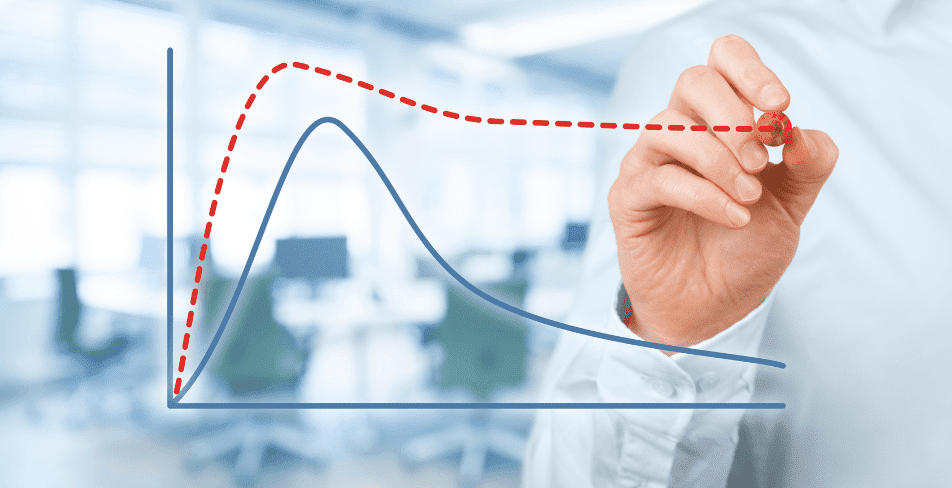
Redegal, Google Partner Premier agency 2025
In general, the product life cycle is the set of different phases through which the commercial item passes from the moment of its manufacture or creation until the moment it leaves the market. This cycle is determined by 5 stages: development, introduction, growth, maturity and decline.

For a long time, attempts have been made to fight against these 5 stages of the product life cycle in order to ensure that products remain on the market as long as possible. But this is not easy, the appearance of more complete and efficient products is inevitable. Keep reading to get the most out of your products, we’ll tell you everything!
The evolution that a product or service undergoes during its presence in the market is called the life cycle. It is marked by the variation of sales and popularity. It is of great importance when marketing, analyzing competitors, market behavior and the situation of the environment are key to establishing the phase in which a product is located and consequently the most appropriate marketing strategy.
It is a chronological process that usually always follows the same steps. Throughout it there are different stages based on certain variables such as sales and benefits. Both tend to evolve following the same curve, increasing at first and decreasing progressively over time. As for digital products, the process may be different since they have the ability to prolong their maturity stage, but over time the time for decline always arrives.
Each product or service has its own life cycle based on how different factors affect it, such as competition or planned obsolescence. But despite the fact that times may vary, the phases are always repeated.
The product life cycle stages are:
As we have mentioned before the life cycle of digital products can have variations, later we will explain the differences in detail.
Efforts to increase and maintain the presence of products or services in the market are continuous and therefore, depending on the phase in which it is found, there are different marketing strategies that help to improve the situation.
In addition to the efforts focused on digital marketing today, it is essential to have a good digital marketing strategy that supports your brand in each of the stages. It is essential to have information about your target audience that allows you to know their tastes and needs in order to create a buyer persona.
In the development stage, more than a strategy, research is necessary, both of the market and of the objective clients. It is time to invest in information.
On the other hand, in the introduction stage the important thing is to attract attention. Marketing expenses are high. Many companies today at this point are committed to visibility in networks. Digital marketing can help you reach a large number of people in a faster and more effective way. Brand awareness can be created through the product’s or brand’s own social networks, but also through collaborations with celebrities or influencers.
The moment of growth is marked by the considerable increase in demand, which is why companies must invest in software that allows them to manage all the information they are receiving as well as operations. Investing in CRM software is one of the best decisions at this point. For this reason, Redegal has promoted the creation of BinnacleData, an analytics solution that collects, integrates and cross-references the main sources of information for your business in one place.
In the maturity phase begins the critical moment where differentiation is the key.
The competition is already considerable and it is not necessary to compete only on prices, the characteristics and updates of the products or services are necessary. A differentiated value proposition must be generated. Entering other market segments should also be considered. Creating marketing campaigns aimed at another target or that serve to show the differentiating elements of the product against its competitors are common in this situation.
Finally, the decline stage where companies must meticulously analyze their KPIs (Key Performance Indicators) to have a clear idea of the situation in which a product or service is in the market and make a decision accordingly. There are several options, withdraw the product from the market, replace it or relaunch it with new features. None of the options is correct or incorrect, it all depends on the analysis of your product and the market.
The life cycle of digital products follows the same guidelines and phases as those of a conventional product. But despite this their life cycles are very different.
n the case of social networks, for example, trends change a lot and their success is short-lived, content must be constantly generated to stay on the audience’s radar and not lose prominence. The life cycle of a social media post varies depending on the platform. Thus, both on Instagram and TikTok, the social networks of the moment, the life cycle of a publication is between 21 and 24 hours. This means that it goes through all the phases in a very short time, hence the importance of perseverance and originality.
These life cycles are marked by the algorithm of each of the platforms. Instagram ranks posts based on their relevance, prioritizing users to see posts from the accounts they interact with the most first. The first 6 hours are decisive to achieve an impact of 50% of impressions, from then on the publication begins the entire life cycle process until it declines in more or less 21 hours.
On the other hand, TikTok is a platform that behaves in a totally different way. The validity of the publications is 24 hours on average but this may vary depending on the account and its behavior. It depends on the amount and frequency of content posting. Even when entering a profile in which you are interested, without even following it, the algorithm randomly shows recent and old content from that account to try to attract attention and identify if it is really part of your interests.
In the case of blogs or applications, the life cycle is longer and more complex, although it always has an end. In these cases, the key is in the updates to be able to extend its life as much as possible.
Consumption always generates waste and in the digital world it is not going to be different. There is the so-called “digital garbage” that refers to all those files that are sent and downloaded, web pages that are visited and social profiles that are no longer used.
All these remains generate an increase in energy consumption produced by data centers, network infrastructures and consumer equipment, which need a lot of energy to keep the entire system active.
If you are looking to get the most out of your digital products and extend their life cycle as much as possible, contact us!
You may be interested in our latest posts

Redegal, Google Partner Premier agency 2025

What is AI Overviews and how will affect SEO?

Bluesky: What is it and how to create an effective strategy

The Super Bowl in a data-driven era
Discover the best digital strategies for your brand
Hi!
We are looking forward to hearing more about your digital business.
Tell us... What do you need?
Fill in the form or call us at (+44) 2037691249